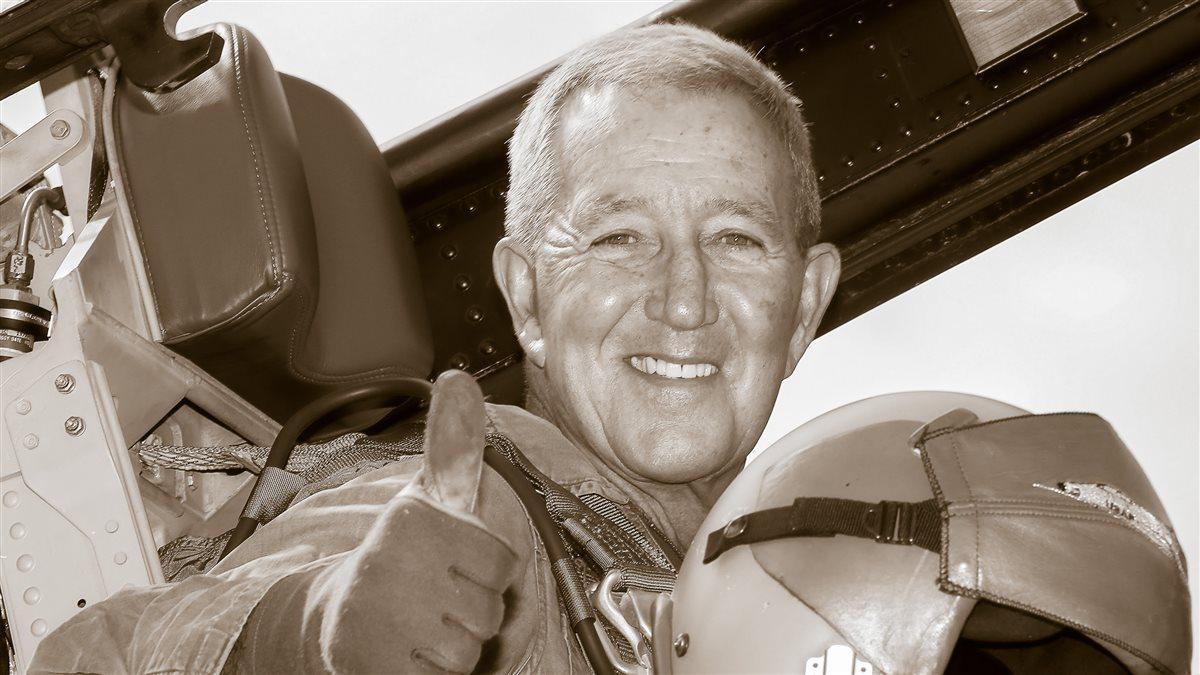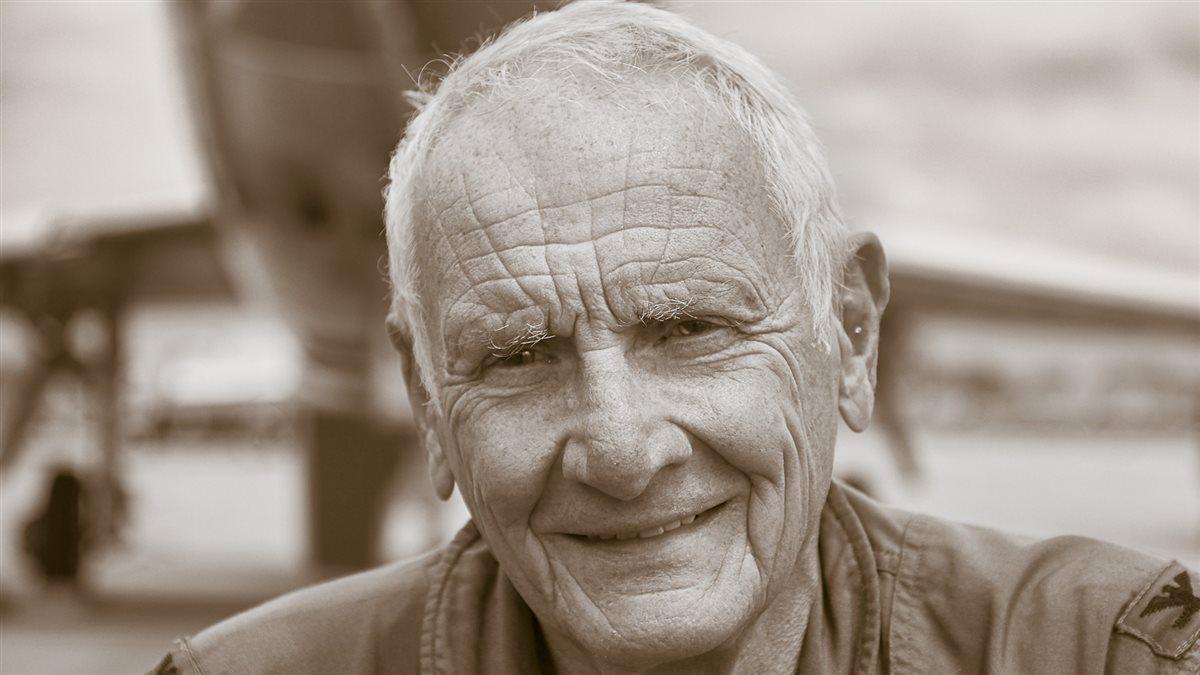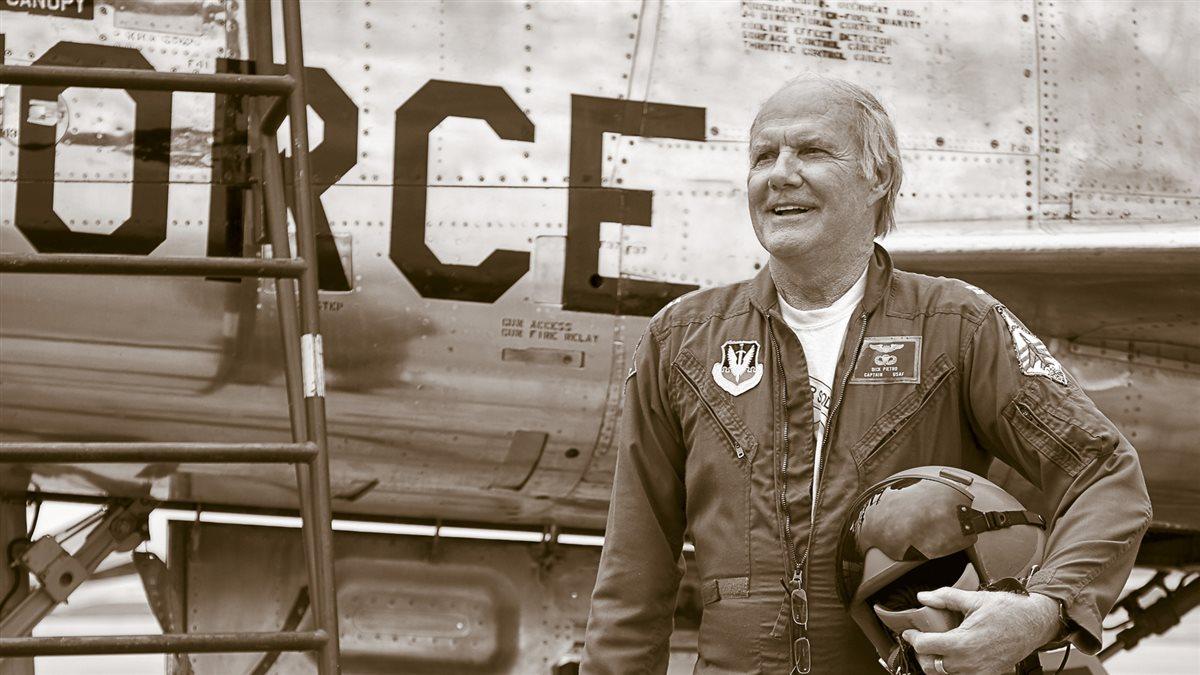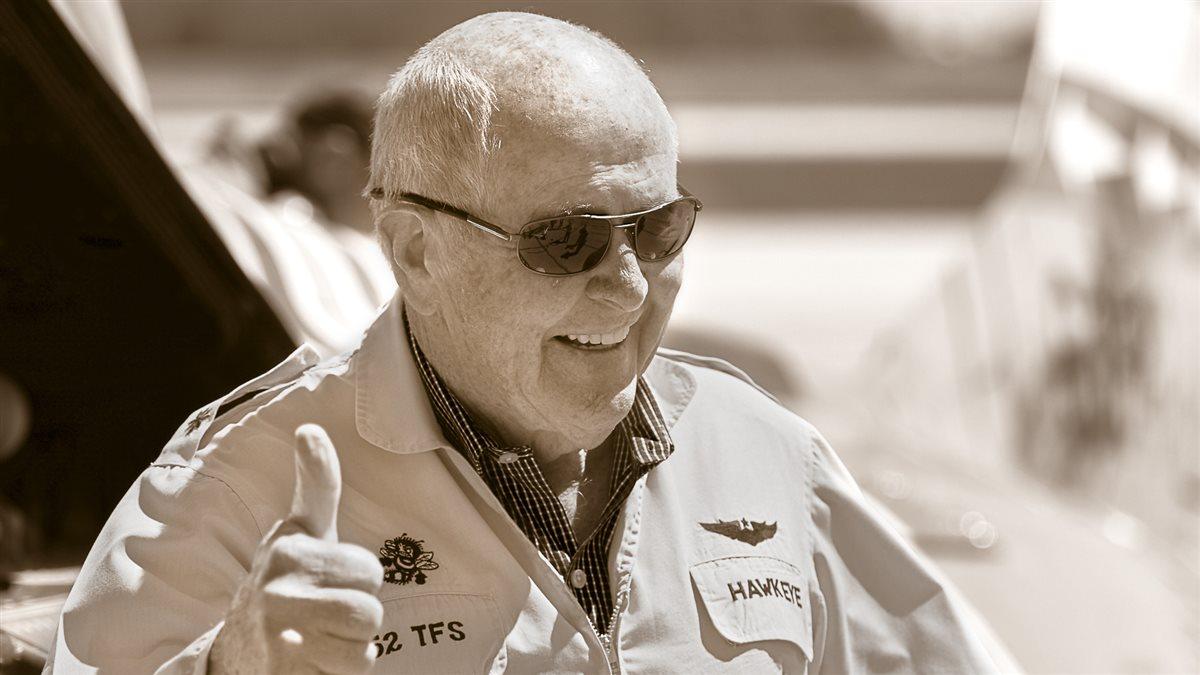One more time
Flying the F-100 is the chance of a lifetime for former fighter pilots
“By the time you got done, you were a cream-of-the-crop fighter pilot,” recalled Robert “Hoppy” Hopkins, executive director and CEO of the Super Sabre Society. In 2015 Hopkins flew the F–100 for the first time in decades, and organized an opportunity for more than a dozen of the 1,400 members in the fraternal organization to fly the “Hun” (for 100) in Fort Wayne, Indiana, in May.
The experience brought much more than the thrill of flying the fighter, evoking the memories, fears, anxieties, and heartache of the war that they had buried for so many decades.It was the first time some of the men had been back in the aircraft since their final combat mission in Vietnam nearly 50 years ago. As they felt a kick in the pants from the familiar burner light on takeoff, the sights, sounds, feel, and smell of Dean Cutshall’s two-seat F–100F (the only one currently flying in the United States, thanks to crew chiefs Paul Swick and James Prezbindowski, who have decades of F–100 maintenance experience) brought the men back to their days as active-duty U.S. Air Force and Air National Guard pilots serving in the Vietnam War. The men paid $5,000 for one-hour flights—roughly the cost of fuel for the warbird that burns 1,000 gallons per hour—but they said flying the Hun one more time was priceless.
The experience brought much more than the thrill of flying the fighter, evoking the memories, fears, anxieties, and heartache of the war that they had buried for so many decades.
According to Hopkins, F–100s flew more than 360,000 missions in Vietnam, most of them to provide nighttime close-air support to troops in the south. Missions involved multiple aircraft working together to aid troops and required precision that would be stressful even in peaceful settings. Forward air controllers talked to troops on the ground and flew at 2,000 feet to relay the location of the fight to other pilots, while Douglas C–47 Skytrains cruised at 10,000 feet to drop phosphorus flares that “put out 3 million candlepower of light” and white smoke to illuminate the target areas. F–100 pilots dove through the flares from 8,000 feet to just 50 or 100 feet above the ground at 450 knots with their lights off to avoid detection before dropping two cans of napalm and two 500- or 750-pound high-drag bombs, and firing four 20-mm revolver cannons with 200 rounds each. Meanwhile intense firefights on the ground created “smoke and flames and things like that coming up to make it even more hazy.”
Precision bombing was essential on these missions, Hopkins stressed: “They ask us to come in and drop such dangerous stuff like napalm and bombs and strafe extremely close to these guys, because the bad guys are literally climbing over the barbed wire trying to get inside of this compound to kill the Special Forces guys.”
Robert Hopkins
303 combat missions
Watch a video interview with Robert Hopkins
 Stationed at Bien Hoa, Hopkins was called off the alert with only minutes to get in the air to fly three close-air support missions in one night to help U.S. Army Special Forces at a base along the Cambodian border. The troops were under heavy attack by the Viet Cong. “Usually they waited until they were in deep trouble” to call, Hopkins said. “I always wished they would have called for us earlier.”
Stationed at Bien Hoa, Hopkins was called off the alert with only minutes to get in the air to fly three close-air support missions in one night to help U.S. Army Special Forces at a base along the Cambodian border. The troops were under heavy attack by the Viet Cong. “Usually they waited until they were in deep trouble” to call, Hopkins said. “I always wished they would have called for us earlier.”
On that night, “as each one of us finished [dropping our ordnance], the next set of fighters would come in to keep the pressure on the enemy,” Hopkins said of his most memorable experience in the Hun. By the time Hopkins went up for this third mission, “dawn was breaking, and the bad guys had broken off the attack because they prefer to fight at night. So they ran back across the Cambodian border.
“At that time during the war, we were not allowed—we, the American forces—were not allowed into Cambodia. That was a political decision and one of our rules of engagement.” The forward air controller told Hopkins and his wingman to return to base, but pointed out the tin buildings that the enemy had fled to just a kilometer across the Cambodian border.
“By now I was physically and emotionally involved in this particular firefight that occurred all night long,” Hopkins said. “So out of frustration—there was nothing else we could do—we went back about 10 miles into South Vietnam, headed back for these corrugated tin huts…and just before the border we pulled up our nose and we jettisoned all of our ordinance toward those things. I have no idea if we hit ’em or not. Maybe we didn’t, probably didn’t, but it made me feel better anyway.”
Hopkins said that a few days later he was on desk duty when a Green Beret walked up to him. “He said, ‘Do you know any of the pilots that have been up there that night?’ I said, yeah, I was. He just said, ‘Thanks for saving,’” Hopkins said, stopping mid-sentence as his eyes filled with tears. Clearing his throat, he continued, “He said, ‘Well, thanks for saving my life.’”
That and another encounter, watching two soldiers come out of the jungle with scratches, welts, and mud caked on their uniforms and boots to get a can of boned chicken from the base exchange at Bien Hoa, led to a turning point for Hopkins. “The sight of these guys all of a sudden put, put it into perspective, you know, who we were protecting when we were doing this close-air support, and it made a big difference.… After that I never felt bad about risking my life to try and help those guys on the ground.”
“By now I was physically and emotionally involved in this particular firefight that occurred all night long,” Hopkins said.
Ed Haerter
194 combat missions
Watch a video interview with Ed Haerter

During a night mission, the F–100 Ed Haerter was flying was hit by a 23-mm round from so close it “hadn’t spun enough times to arm.…It just hit against that spar and fractured it, and the airplane started just wallowing.”
He flew 200 miles back to base in Phu Cat, and it wasn’t until later that he realized how severely the aircraft had been damaged.
“Several things were in my favor,” Haerter said. The aircraft was hit on his last pass, when he didn’t have any Gs on the airplane. Rain and a low overcast at Phu Cat required an instrument approach, so Haerter didn’t fly the typical 360-degree overhead pattern, which would have put Gs on the jet and “pulled the wing off. And when/if you pull the wing off you can’t eject, there’s too much centrifugal force. So, I was very lucky.”
He asked the crew chief to pull the aircraft off the line because it was “flying funny.” “You tell a crew chief something like that, and they basically give you a look like, ‘It sounds like a bad connection between the stick and the seat.’ But they did; they put a different airplane on.” Later, Haerter was called to the flight line. “I’ve never seen so many colonels in my life, and there was a tech rep from North American there. I heard the director of maintenance from our base ask the tech rep, ‘Can we one-time flight it to Taiwan for a new wing?’ And the answer of the tech rep was, ‘Colonel, I would not taxi that bloody thing to the end of the runway.’”
Haerter recalled the tech rep asking him, “‘Are you the one that flew this? You have to be the luckiest SOB I’ve ever met in my life. I just talked to the engineers at the factory, there’s no way that wing should have stayed on.’
“The airplane never flew again. They pushed it off into the weeds and cannibalized it for parts,” Haerter said. “My crew chief went out one day and took the stick grip off—I still have it.”He asked the crew chief to pull the aircraft off the line because it was “flying funny.” “You tell a crew chief something like that, and they basically give you a look like,‘It sounds like a bad connection between the stick and the seat.’”
Dick Pietro
122 combat missions
 When Dick Pietro was activated from Phu Cat Air Base to be part of a mission to provide close-air support to a Special Forces base camp that was under attack along the Cambodian border, he didn’t know he would have a personal connection with one of the men on the ground he was fighting to save.
When Dick Pietro was activated from Phu Cat Air Base to be part of a mission to provide close-air support to a Special Forces base camp that was under attack along the Cambodian border, he didn’t know he would have a personal connection with one of the men on the ground he was fighting to save.
Pietro, who had served in the Army Special Forces before becoming a fighter pilot in the Air National Guard, was talking on the radio to the air liaison officer on the ground to get information about the target, when “this voice comes up and says, ‘Dickie, is that you?’ And I heard this voice, and it was just like an unbelievable experience that my friend John, then lieutenant colonel, was on the ground surrounded by the Viet Cong right in front of me,” Pietro recalled.
Pietro had talked to his friend a couple of months earlier and told John that if he heard the call sign “BAT” that it might be him flying. That day, Pietro’s flight was called BAT 01. “So, how do you think I felt about doing close-air support? You talk about pressing the target and almost having to lay napalm right on my own friend’s troops.”
F–100 pilots flew multiple missions that day to help hold back the Viet Cong. “I didn’t know it at the end of the day, until several months later, my wife told me that John had been seriously wounded that day, on that mission. So, I don’t know how I could top that. I mean it was an emotional experience.” The two remain in close contact.
“This voice comes up and says, ‘Dickie, is that you?’...and it was just like an unbelievable experience that my friend John, then lieutenant colonel, was on the ground surrounded by the Viet Cong right in front of me.”
Richard Graham
352 combat missions
Watch a video interview with Richard Graham
During a night mission from Phan Rang Air Base to support Green Berets, Richard Graham’s F–100 was hit, unbeknownst to him, causing his artificial horizon to stick in one attitude.
 “You’re flying into bright lit [areas] like a football stadium at 500 or 600 miles an hour and then pulling up into the absolute inky darkness, so you had to go into the instrument panel right away,” Graham said. Not knowing his attitude indicator was stuck, Graham put himself into a barrel roll and was flying “into the ground at a high rate of speed. I get a flicker somewhere in my canopy, and I look back, and I’m…pulling myself into the ground. That got my attention.”
“You’re flying into bright lit [areas] like a football stadium at 500 or 600 miles an hour and then pulling up into the absolute inky darkness, so you had to go into the instrument panel right away,” Graham said. Not knowing his attitude indicator was stuck, Graham put himself into a barrel roll and was flying “into the ground at a high rate of speed. I get a flicker somewhere in my canopy, and I look back, and I’m…pulling myself into the ground. That got my attention.”
With the afterburner still engaged, Graham recovered from the unusual attitude and climbed to 15,000 feet before an engine compressor stall “made a terrible noise and blew 60, 80, 100 feet of fire right out the nose, which is shortly right in front of you, and a big explosion. I thought I’d been hit by a SAM [surface-to-air missile] missile, but I didn’t think they had any in Vietnam, in South Vietnam.”
While he was trying to take the airplane out of afterburner and regain control of the jet, the control ship that was with him offered to give him a bomb damage assessment.
“And maybe one of the coolest things I did in Vietnam, I talked to myself in my high squeaky voice until I could get my voice down to level. And then I said, ‘Standby One,’” Graham said, imitating the deep, calm voice he used.
Not all of the pilots in Graham’s 352nd Tactical Fighter Squadron were as fortunate. While Graham was in Vietnam, his squadron “lost 17 pilots, good friends of mine,” he said, tearing up as the memories came flooding back about an hour after his flight in Cutshall’s F–100F. “And I want to cry. I don’t think you want those memories.… I think we all, we all thought our country’s worth our life, and some of us had to give it.”
Email [email protected]









